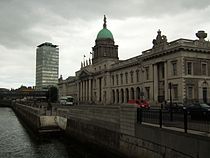- Dublin quays
-
The Dublin quays refers to the two roadways and quays that run along the north and south banks of the River Liffey in Dublin, Ireland. The stretches of the two continuous streets have several different names, however all but three of the names (Swift's Row, Bachelors Walk and Usher's Island) share the same "Quay" designation. The quays have played an important part in Dublin's history.[1]
Much of the southern roadway and a portion of the north roadway is part of the N4 road while another portion of the north roadway is part of the N1 road.
Contents
Routes descriptions
 A view upstream from Grattan Bridge, towards the Four Courts (the domed building), with Essex Quay and Wood Quay on the right bank (left of picture) and Upper Ormond Quay on the left bank (right of picture).
A view upstream from Grattan Bridge, towards the Four Courts (the domed building), with Essex Quay and Wood Quay on the right bank (left of picture) and Upper Ormond Quay on the left bank (right of picture).
Both roadways run approximately 2.4 km (1.5 mi) from Sean Heuston Bridge in the west. The eastern end of the north roadway is at East-Link Bridge while the south roadway turns southward at the Grand Canal. Seventeen bridges cross the river along the line of The Quays, three of them are exclusively pedestrian bridges, one a railway bridge, one other for Luas trams and pedestrians and the remainder for vehicular and pedestrian use.
The name designations of the north roadway are (from west to east): Wolfe Tone Quay, Sarsfield Quay, Ellis Quay, Arran Quay, Inns Quay, Upper Ormond Quay, Lower Ormond Quay, Bachelors Walk, Eden Quay, Custom House Quay and North Wall Quay.
The name designations of the south roadway are (from west to east): Victoria Quay, Usher's Island, Usher's Quay, Merchant's Quay, Wood Quay, Essex Quay, Wellington Quay, Aston Quay, Burgh Quay, George's Quay, City Quay, Sir John Rogerson's Quay and Britain Quay.
A majority of the roadways in the city centre are one-way with the north roadway being eastward and the south being westward.
History
Norman Vikings were the first settlers in Dublin and many Viking artifacts were found at what is now Wood Quay.[2] The quays were first developed during the time of King John in the early 13th Century when the monarch licensed citizens to erect buildings on the River Liffey.[1] They became the center of the Irish shipping trade until the 1800s when the river in this section was considered too shallow for the more modern heavy ships.
 The southern façade of The Custom House on Custom House Quay.
The southern façade of The Custom House on Custom House Quay.
The Custom House, one of Dublin's major landmarks on Custom House Quay, was completed in 1791. The quay takes its namesake from the building. Later, the Four Courts on Inns Quay was completed in 1802 and is currently home to the Supreme Court of Ireland and the High Court. Both were designed by renowned architect James Gandon.
Burgh Quay is named after Elizabeth Burgh, wife of Anthony Foster whose son was Rt. Hon. John Foster last speaker of the Irish House of Commons. ( Now the Bank of Ireland, College Green.) Burgh Quay was once the site of the Tivoli Theatre. The Corn Exchange Building designed by George Halpin in 1815 was approved by the Wide Streets Commissioners in 1816 and work commenced on this building soon afterwards. Its granite facade still remains on Burgh Quay. Shipping came as far upstream as Burgh Quay until 1879 when Butt Bridge was constructed. Many of the buildings on Burgh Quay including No. 8 still retain remnants of the shopfronts designed for the Wide Streets commissioners.
Recent years have brought much development to the quays. One controversial development was at Wood Quay by the Dublin Corporation in late 1900s when there were many archeological Viking finds. This led to a very public and unsuccessful campaign to halt the development.[2]
In 2006, local politicians proposed renaming some of the quays. MEP Gay Mitchell proposed renaming George's Quay or Victoria Quay to Joyce Quay or Behan Quay, named for the iconic Irish writers James Joyce and Brendan Behan.[3]
The Dublin quays in culture
Many artists have found inspirations in and from the quays. Irish novelist James Joyce had many of his stories take place at the Dublin quays, including An Encounter and Eveline. Joyce biographer Michael H. Begnal wrote, "Joyce associated the Liffey Quays with the desire for escape."[4]
Artist Jack Butler Yeats painted "Dublin Quays" in 1916.[5]
Author Frances A. Gerard described the Dublin quays in 1898 as follows: "Much of the picturesque appearance of Dublin is due to the Quays which intersect the City and the Bridges which span the Liffey; they impart to it a foreign air resembling the Quays of Paris."[6]
Ushers Island was the name of a competitor in the 1994 Grand National at Aintree, falling at the third fence.
Notable places on the Dublin quays
- The Clarence hotel (Wellington Quay)
- The Custom House (Custom House Quay)
- Four Courts (Inns Quay)
- Liberty Hall (Eden Quay)
- U2 Tower (Britain Quay)(proposed)
References
- ^ a b Gilbert, John Thomas (1854). A History of the City of Dublin. J. McGlashan. pp. 356. ISBN 0143035266.
- ^ a b Heffernan, Thomas Farel (1988). Wood Quay. University of Texas Press. ISBN 0292790422.
- ^ Nolan, Larissa (May 14, 2006). "Name quays after Irish writers: Mitchell". Irish Independent. http://www.independent.ie/national-news/name-quays-after-irish-writers-mitchell-130192.html.
- ^ Begnal, Michael (200). Joyce and the City: The Significance of Place. Syracuse University Press. pp. 19–20. ISBN 0815629427.
- ^ Pyle, Hilary (1989). Jack B. Yeats, A Biography. Rowman & Littlefield. ISBN 0389208922.
- ^ Gerard, Frances A. (1898). Picturesque Dublin: Old and New. New York City, New York: Hutchinson and Co.. pp. 125.
External links
Categories:- Quays in Dublin (city)
Wikimedia Foundation. 2010.
